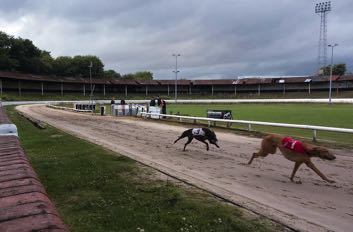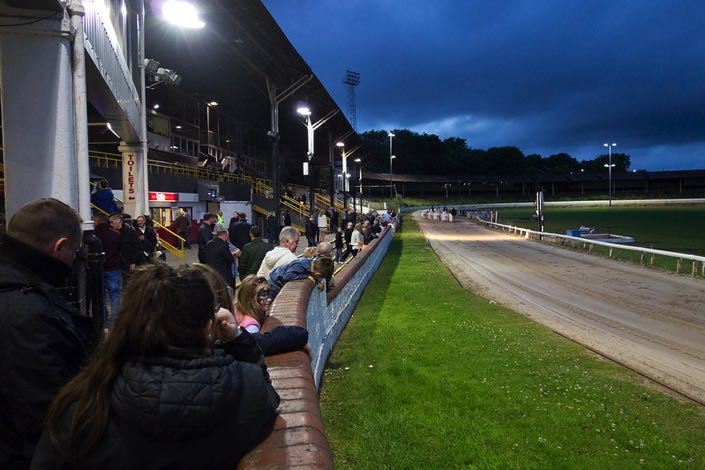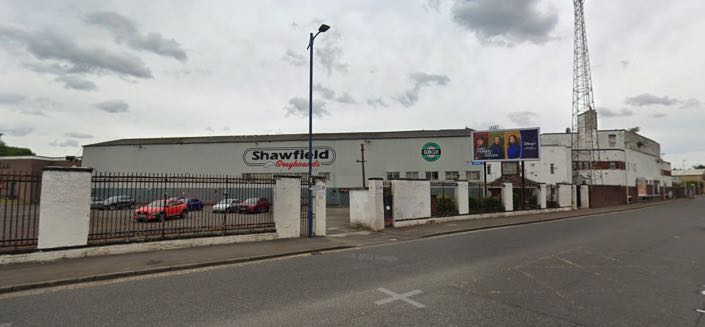- Address: Rutherglen Rd, Rutherglen, Glasgow G73 1SZ
- Status: Permanently Closed

Located in the town of Rutherglen, near the boundary with Glasgow, Shawfield Stadium was the only licensed greyhound venue in Scotland prior to its closure. As well as greyhound racing, the venue has also been used for football matches and speedway events over the years, though it is predominantly greyhound racing for which it was known. John Bilsland already owned a greyhound track in Liverpool and decided to help instigate the opening of a greyhound track in his home town of Shawfield, bringing the sport to the home of Clyde Football Club.
That was in 1932, with football having been played at Shawfield Stadium since it opened in 1898. The Glasgow Tigers speedway team also began using the venue in 1988, with the Scottish Monarchs hosting their speedway events at the stadium for a single year in 1996. As is so often the case, the closing of the track has left something of a hole in the local community, but the fact that the trainers took their greyhounds to other venues when Shawfield Stadium failed to re-open in the wake of the global health crisis means it’s unlikely to ever re-open.
Major Races & Events
Being the only stadium in Scotland that was licensed by the Greyhound Board of Great Britain, it is hardly a surprise that Shawfield Stadium was the home of one of the country’s biggest races. Indeed, the only real shock is that the venue wasn’t used for more than the two well-known events that were hosted there on a regular basis. That being said, it isn’t overly surprising that Scotland as a country didn’t have a wealth of top-class greyhound races that needed hosting, hence the reason there was only one licensed venue.
Scottish Greyhound Derby
Inaugurated at Carntyne Stadium in 1928 and taking place there for the next forty years, the Scottish Greyhound Derby was moved to Shawfield in 1970 after Carntyne closed. It remained there until 1985, at which point it was moved to Powderhall Stadium in Edinburgh by the Greyhound Racing Association. It returned to Shawfield when the GRA sold Powderhall and stayed there until Shawfield Stadium itself closed. Run over 480 metres on a sand track, the Scottish Greyhound Derby has seen some big-name winners of the years, including Trev’s Perfection and Patricias Hope.
St. Mungo Cup
First run in 1927, the St. Mungo Cup was, like with the Scottish Greyhound Derby, a race that took place at Carntyne Stadium. It soon became one of Scotland’s leading events in the sport, moving to Shawfield Stadium in 1973. It remained at its new home for more than 30 years, being discontinued after the 2009 running before being brought back for a one-off event in 2016. It was run over 500 yards at Carntyne, which became 480 metres once the switch to Shawfield took place. Having enjoyed numerous sponsors over the years, the 2016 running was its last.
In the News
In October 2022, the Member for Scottish Parliament for the area where Shawfield Stadium stands, Clare Haughey, confirmed that there was no way back for greyhound racing at the venue. Statistics showed that 197 dogs were injured and 15 died between 2017 and 2020 at the racetrack, leading to calls for the sport to be banned completely north of the border. Though that is unlikely to happen any time soon, it also doesn’t really need to where you consider that Shawfield was the country’s last licensed venue.
About Shawfield Greyhound Stadium

In many ways, it is impossible to talk about Shawfield Stadium the greyhound racing venue without talking about it as the home of Clyde Football Club. That is because Clyde took over what was previously a trotting track in 1898, having previously been based on the other side of the river. There was always a sense that the stadium could be used for more than just football matches, thanks to Clyde earning extra revenue from the likes of boxing and track and field events. This also extended to greyhound racing, which arrived at Shawfield Stadium in 1932.
In spite of all of this, Clyde FC’s revenues didn’t improve and in 1935 a decision was taken to sell the stadium to the Shawfield Greyhound Racing Company Limited. They allowed the football club to continue to play its matches there as tenants, but greyhound racing became the major focus of the venue. The sport had been introduced by John Bilsland, who owned a greyhound stadium called Stanley in Liverpool and wanted to see races take place in his home town of Clyde. The Football League was opposed to hosting greyhound races, so work needed to be done to allow it.
Greyhound Racing Arrives at Shawfield
The greyhound racing track at Shawfield Stadium arrived on the 14th of November in 1932, with the circuit being an impressive 473 yards long. This included banked bends and 125 yard straights, causing it to become a popular place for racing lovers to head. It needed this sense of popularity, considering the fact that the city of Glasgow already boasted National Greyhound Racing Society licensed greyhound racing venues in the form of Albion, Carntyne, White City and Firhill.
On top of the licensed venues, Clydeholm, Coatbridge and Mount Vernon also operated as independent tracks, showing just how popular greyhound racing was in Scotland at the time. Swordmanship won the first ever race at Shawfield Stadium, completing the 303-yard event in 18.45 seconds, having been given six yards in the handicap event. Things continued much the same at the stadium until the outbreak of the Second World War, at which point racing only took place sporadically until the way’s conclusion.
The Post-War Years
In the wake of the Second World War, the Shawfield Greyhound Racing Company was valued at £4,000 by the taxman. The owners, meanwhile, proposed that it was worth just £600, which unsurprisingly led to a dispute. Greyhound racing remained popular at the time, leading to the track enjoying a profitable spell at the start of the 1950s. Sadly, the sport’s decline led to both Firhill and Albion closing by the end of the decade, with White City following in 1962 and Carntyne in 1968. This, though, was good news for Shawfield, which inherited races and dogs from the other locations.
The fact that the Greyhound Racing Association owned Shawfield meant that it benefitted from some big competitions heading its way, including both the Scottish Greyhound Derby and the St. Mungo Cup. Unfortunately, a major fire in 1975 resulted in many of the stadium’s facilities being destroyed. An investment program was put in place to get things back on track, including the installation of a totalisator system, photo finish equipment and ray timing. The track was then allowed to host the 1976 Intertrack Final.
The Beginning of the End
It feels odd to talk about the beginning of the end for a track that closed in 2020 starting in the 1980s, but that is when murmurs began to emerge about the stadium having an uncertain future. In 1983, the track was put on the open market and three years later Clyde Football Club was asked to leave. A former bookmaker and Racing Manager named Billy McAllister moved to help save the track, helping to form the Shawfield Action Group. Around 8,000 people signed a petition, with a consortium buying it instead of property developers.
The track re-opened under the ownership of the Shawfield Greyhound Racing and Leisure Company Limited on the 11th of June in 1987 and the general feeling was that everything would be ok. A year later and the GRA lost the rights to host the Scottish Greyhound Derby after it sold Powderhall, allowing it to return to Shawfield Stadium. The takeover also saw the return of the St. Mungo Cup and the William King Cup, in addition to a facelift that cost in the region of £100,000 to carry out, improving the facilities.
Track Records at Shawfield
As with every greyhound racing track around the country, Shawfield Stadium has seen some impressive records set over the years. There are records recorded in both pre and post-metric measurements, though we are obviously only really interested in the post-metric ones that have been set in the modern era of greyhound racing. That being said, a fair chunk of the records are from the 1980s. Rather than give you every distance that was run at Shawfield Stadium, here’s a look at the more pertinent records:
| Distance | Record Time | Date Set |
|---|---|---|
| 300 Metres | 17.35 Seconds | 7th April 1990 |
| 480 Metres | 28.63 Seconds* | 2nd April 2016 |
| 500 Metres | 29.39 Seconds** | 21st May 1994 |
| 670 Metres | 40.50 Seconds | 11th September 1993 |
| 730 Metres | 45.09 Seconds | 20th February 1998 |
| 882 Metres | 56.55 Seconds | 13th April 2002 |
| 932 Metres | 59.35 Seconds | 2nd September 1993 |
| 500 Metre Hurdles | 31.07 Seconds | 25th May 1982 |
*Record was set during the semi-final of the Scottish Greyhound Derby
**Record was set during the final of the Scottish Greyhound Derby
The Closing of the Track: What Happened to Shawfield Greyhound Stadium?

A large Tote board had dominated the south end of the track for decades, but in 2004, a decision was taken to demolish it. Things were still not looking good for the track from a finance point of view, with many fearing that its days were numbered. Still it ploughed on, though it was felt as though the writing was one the wall when the St. Mungo Cup was discontinued in 2009. An attempted return for the race seven years later ended in failure, meaning that there weren’t many people left that thought Shawfield had much of a future.
Even so, it took the arrival of a global health crisis for the track to final close its doors. By that time, it was the final licensed track left standing in Scotland. By 2022, the venue had stood empty for around two years and there was little appetite for it to re-open as a greyhound racing stadium. The owners, meanwhile, were reportedly looking to turn the site into housing, depending on the results of an environmental report into possible contamination there. At the time of writing, there is no sign of it re-opening for any sport.